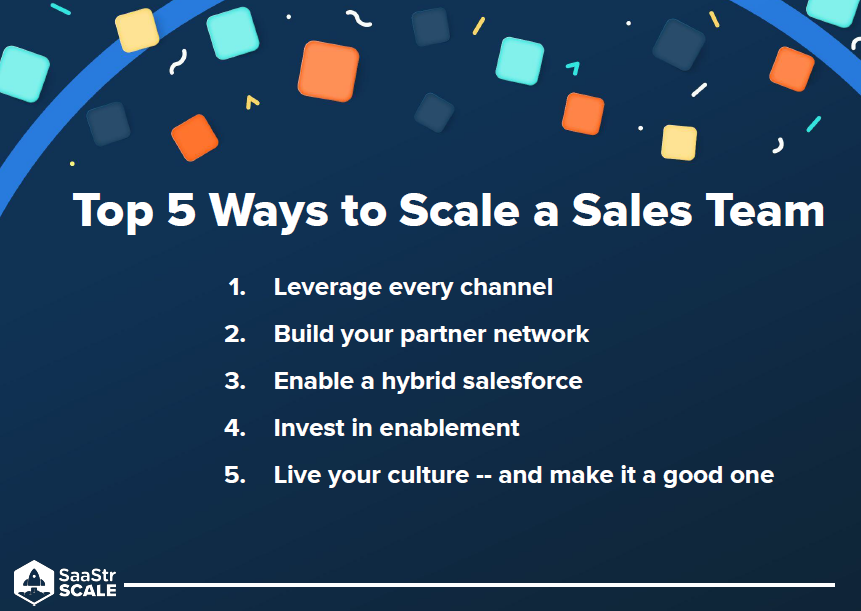As you scale up a business, you’ll see an increase in demand for product, followed by an inevitable increase in sales. As a result, you’ll have to hire more people, reform your processes, and tailor your systems to accommodate the new demand—all without breaking anything.
But how should you proceed when it comes to scaling your sales team?
Ryan Azus, the Chief Revenue Officer (CRO) of Zoom, shares with Bryan Elsesser, SaaStr VP of Sales, how he scaled their remote sales team to adapt to the growing demand as they went from 10 million active daily users to 300 million users in a very short period.

5 ways to scale your SaaS and sales team
1. Leverage every channel
A channel can have different meanings. But before you focus on leveraging channels, there are some things you should focus on to make the full use of them, like:
- Who is your customer?
- What is your product-market fit?
- Are you a new product, or are you replacing an existing service?
Once you have these answers, you can focus on channels:
- Direct sales with partners
- Online channels: these are especially important if you have an audience in different countries but no salesforce to support the demand. For example, Zoom had a scalable eCommerce store that acted as an outlet for customers to be enabled and serviced without a sales representative.
Additionally, it’s also important to segment based on the size of your business before you start leveraging channels. This can be as simple as separating your processes and audience for inbound and outbound or defining the meaning of a small business and enterprise to tailor your processes for them.
At Zoom, we sell to individuals, small businesses, large enterprises, 50% of the Fortune 500 and also, the Global 10. But we don’t do it with the same sales processes, representatives, or go-to-market tactics.
Segmentation is crucial to understand how you want to scale your team and what you need to do that. Here are some questions you can answer to segment your users and channels:
- What does a specific customer group need?
- What are their buying patterns?
- What’s the competitive market for this customer group like?
- What should you do differently?
- What effective traditional sales tactics can also apply to this customer group?
2. Build your partner network
Zoom has expanded to 3,500 partners in the past year alone, totaling a whopping 9,000 partners who make up 25% of their non-online business globally. This led them to double their partner relations sales team and to invest in partner programs and automation.
However, partners don’t come in any one type for you to build your network around, so think about what you’re selling and what you need..
There’s everything from Global System Integrators at the top end, to Master Agents working in the UCAS world as sales agents, to VARs and its distributors and others who focus on service-oriented businesses.
Your partner networks will also differ with each country. For example, Master Agent is a very successful program in the USA, but it barely exists in Asia. So partner networks are not one-size-fits-all; they differ with businesses based on what’s needed by a specific customer segment and the market.

3. Enable a hybrid salesforce
It’s not easy to build and manage a sales team in two places—physically present and remote. But having clarity on certain things help, like:
- What are the metrics you want to manage?
- How do you want to enable your team?
- Where will team members go to get answers?
- How will you create a hybrid culture that’s followed?
- How will you ensure teams are getting together virtually?
- How will you find pick-me-ups since sales are always going up and down?
Zoom managed a hybrid salesforce amidst the growing demand through investments in technology to reframe how their team members work in their home and in-office environment.
4. Invest in enablement
Enablement is core to creating a culture of learning and productivity.
When you’re a small business, you need to listen to the customer to see what they need, what’s working, and what’s not working. But, you also need to pay attention to what’s working across the sales floor and how you can make it repeatable and scalable. Enablement is the answer to it—be it across sales, or product marketing.
The world is moving very fast—the technology, competition, product releases, customers’ needs, and situations worldwide. So there are a lot of things sales folks need to know and understand, which largely depends on how you enable them.
Zoom, for instance, invests in online learning, organizes 30-minute sessions with experts on core topics, and creates information banks to enable and educate the salesforce in the company while encouraging them to come back to this information again and again.

5. Live your culture—and make it a good one
Zoom’s culture is about delivering happiness in a caring and sustainable way, which stems from its core value of caring—for the company, customers, teammates, and community.
However, a sales culture is different (but not independent) from the company culture.
A sales culture requires building a team environment where everyone has their quotas and groups but with a single motive of winning together. This also means that you need to build a team of people who don’t just care about themselves but also make everyone around them better.
Zoom embodies this culture, recognizes those making a difference, and rewards them with promotions into leadership roles. The key to living your culture is to foster values and focus on the little things that make everyone better every day.

